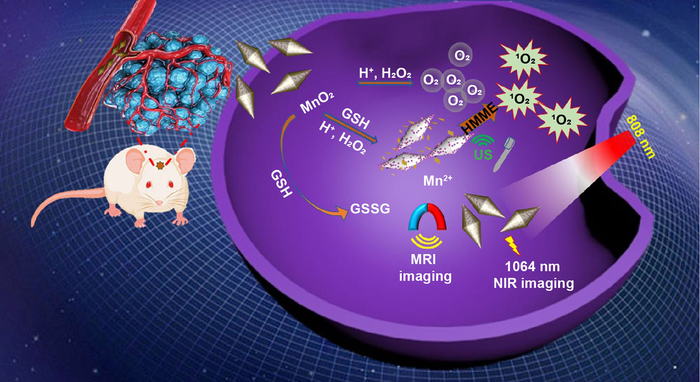Glioma is an intracranial malignant tumor that still poses a major clinical challenge due to its highly invasive nature, low cure rate, and high mortality rate. Although advanced molecular imaging techniques, such as magnetic resonance imaging (MRI) and computed tomography (CT) can be used for glioma diagnosis, their low spatial resolution, harmful ionization, and complicated workflow limit their application in real-time intraoperative imaging.

Credit: by Zhijia Lv, Longhai Jin, Yue Cao, Hao Zhang, Dongzhi Xue, Na Yin, Tianqi Zhang, Yinghui Wang, Jianhua Liu, Xiaogang Liu, Hongjie Zhang
Glioma is an intracranial malignant tumor that still poses a major clinical challenge due to its highly invasive nature, low cure rate, and high mortality rate. Although advanced molecular imaging techniques, such as magnetic resonance imaging (MRI) and computed tomography (CT) can be used for glioma diagnosis, their low spatial resolution, harmful ionization, and complicated workflow limit their application in real-time intraoperative imaging.
In a new paper published in Light Science & Application, a team of scientists, led by Professor Hongjie Zhang and Professor Yinghui Wang from State Key Laboratory of Rare Earth Resource Utilization, Changchun Institute of Applied Chemistry (CIAC), Chinese Academy of Sciences, China, Jianhua Liu from Department of Radiology, The Second Hospital of Jilin University, China, and co-workers have developed a core-shell structured nanotheranostic agent (YVO4:Nd3+-HMME@MnO2-LF, marked as YHM) with YVO4:Nd3+ particles as the core and MnO2 nanosheets as the shell. Sonosensitizer hematoporphyrinmonomethyl ether (HMME) and lactoferrin (LF) were further loaded and modified on the surface, giving it a good ability to cross the BBB, near-infrared fluorescence imaging in the second window (NIR-II)/MRI bimodality, and highly efficient sonodynamic therapy (SDT) of orthotopic gliomas. The YVO4:Nd3+ core exhibited good NIR-II fluorescence properties, enabling YHM to act as promising probes for NIR-II fluorescence imaging of vessels and orthotopic gliomas. The MnO2 shell can not only provide O2 in the tumor microenvironments (TME) to significantly improve the healing efficacy of SDT, but also release Mn2+ ions to achieve T1-weight MRI in situ. Non-invasive SDT can effectively restrain tumor growth. This work not only demonstrates that multifunctional YHM is promising for diagnosis and treatment of orthotopic glioma, but also provides insights into exploring the theranostic agents based on rare earth-doped yttrium vanadate nanoparticles.
Journal
Light Science & Applications
DOI
10.1038/s41377-022-00794-9




